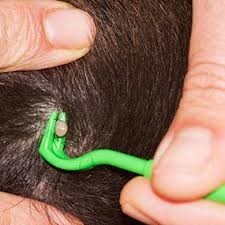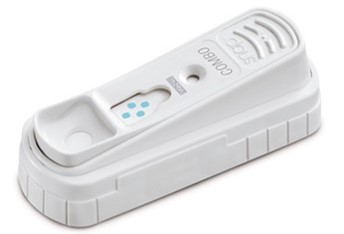How to properly remove a tick?
Purchase special tweezers for tick removal from your veterinarian. Place the tweezers as close to the body part of the attached tick as possible. Gently twist the tweezers to release the biting part of the tick (the head) and pull the tick away from the body. Make sure you remove the whole tick (head and body including legs). Place the tick in a sealable container of 70% ethanol and refrigerate it for possible laboratory analysis. Disinfect the site where the tick was attached with a disinfectant solution or warm salt water. Remember to act quickly when handling ticks, as early disposal reduces the risk of tick-borne diseases.

The current humid weather is a period with a higher incidence of ticks in nature. Dogs and cats can bring an unwelcome guest from the walks in the form of a tick and with it some serious diseases.
Up to 28% of ticks transmit serious diseases
28% of ticks are carriers of some of the serious diseases, such as anaplasmosis, Lyme borreliosis, ehrlichiosis or heartworm disease. Every twelfth Borrelia-positive tick is a carrier of yet another pathogen - according to the results of more than 13,000 ticks examined in the Protean laboratory.
Ticks are one of the most common parasitic diseases of dogs and cats. The tick (Ixodes ricinus) is the most common parasite in our country. It represents up to 90% of the tick population living in our country. The male is reddish brown to black, the female is yellow-red. After soaking, it has a grey colour and a size of up to 1 cm. It occurs in deciduous and mixed forests with bushy undergrowth in lowlands and hills at altitudes up to 600 m above sea level. It occurs in nature from April to October with a maximum occurrence in May and September. Under favourable conditions, we can meet a tick all year round. In mild winters, we observe ticks on animals in January. Ticks are greatly affected by outdoor temperature and relative humidity. They require at least 6-9 °C to be able to suck. They also need humidity higher than 70-80%, and therefore we practically do not see them on dry summer days.

MVDr. Marek Galbinec advises on TV Nova how to properly remove ticks.
Tick-borne diseases
Lyme borreliosis
Lyme borreliosis is the most common tick-borne disease. Ticks Ixodes ricinus transmit Borrelia to both humans and dogs. The cause of the disease is bacteria from the group of spirochetes, Borelia burgdorferi. Named after its discoverer Dr. Willy Burgdorfer, who detected bacteria in ticks in 1981. It was discovered in the town of Lyme (Connecticut, USA).
Dogs are often infested with a large number of ticks, so the risk of Borrelia infection is relatively high. Borrelia affects the immune system by causing chronic inflammation of various organ systems, leading to permanent damage. Symptoms of this disease, which often occurs during summer and autumn, are non-specific: Sudden deterioration of general health, occasionally high fevers, inflammation of one or more joints (swelling, alternating limping, refusal of movement), malaise, lymph node enlargement, acute or chronic kidney disease, vomiting, weight loss, pain. Episodes of lameness usually last only a few days, although repeated episodes can occur. Other manifestations include neurological and cardiac symptoms and general malaise. For non-specific symptoms, diagnosis is difficult and often delayed.
Dogs can be vaccinated to protect against possible infection and clinical manifestations of Lyme disease. Risk groups for vaccination are dogs with proven clinical disease Lyme borreliosis when vaccination will no longer improve the condition of the vaccinated animal. Borrelia germs remain in well-protected places throughout the dog's life, regardless of treatment or vaccination - such as articular cartilage. Vaccination of an already sick animal is therefore unnecessary, because despite the vaccination, borreliosis can break out at any time (stress, other infectious diseases, etc.).
Diagnosis of the disease
At the Vethope Veterinary Clinic, we use the SNAP 4Dx Plus rapid test to diagnose this disease. We need a small sample of the animal's blood for it. The test results are then available on hold. This quick test is excellent for screening dogs infected with Lyme disease. It can be used in a screening program for dogs without clinical signs of disease, or if there is already a suspicion of Lyme disease. However, positive test results do not appear until 4 - 6 weeks after exposure of the animal to ticks.
Therapy
Antibiotics have been used for a long time to treat Borrelia. Therapy is more successful if it is started at the beginning of the disease. The disease after the transition to chronicity is incurable, affected dogs refuse to walk, have neurological deficits or have kidney failure.
Prevention
For dogs, there is a vaccine against Lyme disease, which after revaccination protects the dog for 1 year. Vaccination of dogs that are positive for Lyme disease have not yet shown clinical signs to prevent a new infection.
In addition to vaccination, the animal should be regularly treated against ticks - the veterinarian will advise you on a suitable product.
Ehrlichiosis
Ehrlichiosis is caused by bacteria belonging to the Rickettsia group. Rickettsia is a major pathogen in both human and veterinary medicine. Ticks of the genus Ripicephalus and Dermacentor are the transmitters. They occur in geographical areas with an abundance of warm days. Canine ehrlichiosis is caused by the bacteria Ehrlichia canis or Ehrlichia ewingii, which attacks the cells of the immune system. Bacteria can be present for months or years without clinical signs. Due to chronic, subclinical infection, dogs can be transported to non-endemic areas and subsequently symptoms of the disease are developed. Symptoms are non-specific, which often results in late diagnosis. In the acute phase (1-3 weeks after being bitten by an infected tick), fever, enlargement of the lymph nodes and spleen, lethargy, depression, weakness, difficulty breathing, or bleeding may occur. In the chronic phase, fevers, anaemia, weight loss, nosebleeds, pneumonia, eye pain, renal failure, lack of coordination, and frequent bacterial infections occur. As with Lyme disease, the course of Ehrlichiosis is chronic, with a deteriorating tendency.
Therapy
Therapy is possible, but usually ineffective due to late diagnosis. Sick dogs lose weight and suffer from frequent infections of the skin and respiratory system, which often end in euthanasia of the animal. Treatment consists of long-term application of antibiotics. Most dogs improve clinically within 24 to 48 hours. Dogs with severe chronic illness may not respond to treatment or the problem will return after a few months.
Prevention
Effective vaccination against ehrlichia canis is not currently available. The only prevention is regular effective protection against ticks, or timely removal of sucked ticks.
Anaplasmosis
Anaplasmosis is an infection that can be transmitted to your dog by ticks. Anaplasmosis is caused by the microorganism Anaplasma phagocytophilum, which is transmitted by ticks of the genus Ixodes, and Anaplasma platys and the North American tick Rhipicephalus sanquineus. Because Borrelia burgdorferi is also transmitted by the common tick, Ixodes ricinus, infection with B. burgdorferi and A. phagocytophilum is often detected together, and the two pathogens can increase each other's pathogenicity. In these cases, the clinical symptoms are more severe.
Period between infection and the first symptoms is 4-11 days, although many dogs do not show clinical signs of disease even 21 days after infection. The disease may include fever, malaise, loss of appetite, enlargement of the spleen, resistance to movement, stiffness, weakness, limping, joint pain, vomiting and diarrhoea, anaemia and decreased platelet counts.
Diagnosis of the disease
It is difficult to make a diagnosis based on clinical symptoms alone.
Therapy
Treatment consists of antibiotics and symptomatic therapy. Dogs respond quickly to treatment and improvement occurs within 24-48 hours, normalization of symptoms within 6 days.
Prevention
Preventive examination for anaplasmosis is performed at the request of the owner during the annual preventive examination of the animal. In dogs exposed to a high risk of infection (eg hunting, shepherd dogs, etc.) it is advisable to perform a diagnostic test twice a year - always in spring and autumn, outside the main season of tick occurrence. Diagnosis is also performed with a simple Snap 4Dx plus test.
The vaccine is not currently available. Therefore, we emphasize the prophylaxis against ticks with proven types of products (pipettes, tablets or collars).
Babesiosis
Babesiosis is a serious disease of humans and dogs caused by protozoa. The species that cause disease in dogs are Babesia canis and Babesia gibsoni. These protozoa attack red blood cells, in which they multiply and cause an infection that can be very serious.
In the Czech Republic, the most important carrier of babesiosis is the floodplain drinker (Dermacentor reticulatus), which occurs in forests around large rivers. Another possible vector is the common tick (Ixodes ricinus). Within the European continent, babesiosis is most common in the Mediterranean (Croatia, Greece, Italy). However, cases of the disease are increasingly being reported in more northern areas (Germany, Austria, Poland) and especially in Slovakia.
Diagnosis of the disease
The incubation period of babesiosis is 10-21 days. The disease can be asymptomatic, acute, or chronic. The asymptomatic course can be the cause of chronic fatigue syndrome.
The acute course is manifested by anorexia, fever, and general depression of the animal, and after 2 to 3 days, blood appears in the urine, jaundice, and enlargement of the spleen. As a result of the loss of red blood cells, anaemia occurs. In some cases, especially in puppies and sick or otherwise debilitated dogs, the acute stage can end in death.
In the case of a chronic course of babesiosis, alternating fevers, a general decrease in condition and anorexia appear. Inflammation of the stomach, mucous membranes of the oral cavity, muscle inflammation, dyspnoea and circulatory disorders associated with increased bleeding, central nervous system involvement, which can lead to paralysis or even epileptic seizures, occur. In addition, the disease may be complicated by another concomitant tick-borne infection such as ehrlichiosis or borreliosis.
Treatment and prevention
Babesiosis can be treated with specific antibacterial agents. The main disadvantage of these drugs is the possibility of serious side effects and poor tolerability. Therefore, prevention and early detection of possible tick infectivity is essential.
Above all, it is very important to prevent the tick from biting, there are several anti-tick agents available. In case the dog is infected with a tick, it is advisable to use the possibility of determining the risk of transmission of infectious diseases from the attached tick by examination in the laboratory. With the early detection of the possibility of infection, treatment is not as demanding and expensive as with a full outbreak.
How to remove a tick
• Buy special tweezers for removing ticks from your veterinarian.
• Place the tweezers as close as possible to the body of the attached tick.
• Turn the tweezers to release the bite part of the tick's body, the so-called head, and gently pull the tick away from the body.
• Turn the tweezers over and check that you have really removed the whole tick (head and body with legs).
• Place the tick in a test tube or clean sealed glass pre-filled with 70% ethanol and store it in the refrigerator for possible analysis in the laboratory.
• Clean the area where the tick has been sucked with disinfectant solution or warm salt water.
• DO NOT USE A CLASSIC PINZET! The body part of the tick could be separated from the head part and will remain in the skin. It is then a common cause of infection and the subsequent need for antibiotic treatment.
• If you have any concerns about whether you have removed the ticks correctly, contact your veterinarian.

Mosquito-borne diseases
Mosquitoes attack humans and animals. Their sting is manifested by hives or an allergic reaction. Some species are dangerous vectors of infections. Richly furred areas are well protected from mosquitoes. Therefore, they mainly attack the base of the abdomen, ears, and eyelids. Greater problems can be expected in breeds with sporadic hair (Chinese, Mexican and Peruvian hairless dogs, Sphinx cats, etc.).
Dirofilariosis
Mosquitoes transmit Dirophilariasis to animals. It is caused by parasites. Adults of this hairy nematode live in the heart and lay larvae in the host's blood.
Carriers of the branches are various types of mosquitoes that commonly occur in the Czech Republic. In the past, these parasites occurred only in areas with tropical and subtropical climates, but in connection with global warming and migration of humans and animals, we can now commonly encounter them in our latitudes, such as Hungary, Slovakia, and the Czech Republic. Due to the occurrence of mosquitoes, there is a risk of this infection spreading rapidly.
The cause of cardiac heartworm disease is Dirofilaria immitis (canine heartworm). Adults are up to 30 cm in size and parasitize in the right ventricle and atrium and in the pulmonary vessels. Females produce larvae directly into the bloodstream. The mosquito absorbs these microfilariae, in its organism they are transformed into infectious larvae within 14 days at an outdoor temperature higher than 15 ˚C, which the mosquito passes on to the new host during further sucking together with the secretion of the salivary glands. Adults can then live in the heart for 5 to 7 years or more. The larvae can also cross the placenta and the sick mother can infect the puppies.
Diagnosis
Serious heart disease caused by this parasite manifests itself in various ways. If only a few adult parasites are present in the heart, we observe fatigue after exercise and occasional coughing. In the case of infection with many parasites, the symptoms are more severe - pallor of the mucous membranes, cough, emaciation, poor coat quality, increased heart rate and, in severe cases, momentary fainting.
The disease can be diagnosed by cardiological examination, including radiological and ultrasound examination of the heart. Larvae produced by female ferns can be detected by laboratory blood tests (Knott's test) or by detecting the presence of adults by blood serum testing. (ELISA method).
Therapy
The treatment of this infection has two phases. In the first, we give a medicine that kills adult parasites and at the same time a special medicinal product that prevent these released parasites from clogging blood vessels and causing embolism.
The second phase of treatment aims to eliminate larvae that circulate in the dog's blood. The prognosis is good especially at the beginning of the disease, when only a small amount of hair follicles are present. The advanced stage usually ends in heart and kidney failure.
Prevention
During periods of increased incidence of insects, we recommend avoiding high-risk areas and treating pets with certified repellents.
A unique rapid test for early diagnosis of tick-borne and mosquito-borne diseases
The SNAP 4Dx® Test is the only rapid clinical test that can determine the 4 most common diseases of dogs transmitted by ticks and mosquitoes: Anaplasmosis of dogs (Anaplasma phagocytophilum), Lyme disease (Borrelia burgdorferi), Ehrlichiosis of dogs (Ehrlichia canis) and Dirofilariasis. The test can be performed on an outpatient basis. One sample of the animal's blood is sufficient for the examination. Contact your veterinarian at the Vethope for more information.

We collect ticks to protect your four-legged pets
The Vethope Veterinary Clinic has become one of 15 specialist workplaces in the Czech Republic where a tick collection project is underway to research the spread of tick-borne infectious diseases to animals and humans. More info here.
Warning: This article is for information only and does not replace professional consultation or examination of the animal by a veterinarian. If you have any doubts about the health of your pet, contact your veterinarian immediately.
12.03.2024

